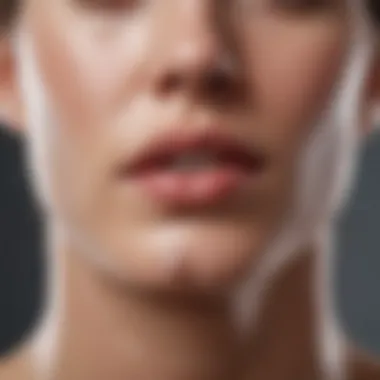Effective Strategies to Prevent and Treat Ingrown Hairs


Intro
Ingrown hairs are a situation faced by many individuals. This common skin issue arises when hair follicles curl back into the skin instead of growing outward. As a result, it can lead to pain, redness, and sometimes even infection. The aesthetic concerns, such as bumps or dark spots on the skin, often add to the discomfort and frustration. Understanding the reasons behind ingrown hairs, along with effective prevention and treatment strategies, can be significant for those who regularly engage in hair removal.
In the sections that follow, we will explore various facets of ingrown hairs. From definitions and causes to practical solutions, the aim is to equip readers with knowledge to manage this condition effectively. Whether you are dealing with occasional ingrown hairs or face the issue frequently, the comprehensive insights provided will help you maintain smoother, healthier skin.
Understanding Ingrown Hairs
Ingrown hairs are more than just an aesthetic concern; they can lead to significant discomfort and skin conditions if not addressed properly. Understanding the nature of ingrown hairs sets the groundwork for both prevention and treatment strategies, safeguarding skin health. This section will delve into the definitions and characteristics of ingrown hairs, as well as the common areas where they tend to manifest, providing essential knowledge for readers seeking effective solutions.
Definition and Characteristics
An ingrown hair occurs when hair grows back into the skin rather than out of the follicle. This can happen either because the hair is trapped under the skin's surface or due to improper shaving techniques. Ingrown hairs often lead to the formation of small, reddish bumps that may become itchy or painful.
The skin lesions caused by ingrown hairs can sometimes be confused with pimples or folliculitis, which is inflammation of the hair follicle. It is essential to recognize the distinctions to apply the appropriate treatment effectively. The characteristics of ingrown hairs include:
- Heightened Sensitivity: Areas affected by ingrown hairs can be sore or tender.
- Visible Redness: The skin often appears red and inflamed.
- Pustules: In some cases, the area may develop pus-filled bumps, indicating possible infection.
- Variability: Symptoms may vary among individuals, dependent on skin type and hair texture.
Common Areas Affected
Ingrown hairs can occur anywhere on the body where hair grows. However, certain areas are more commonly affected. The more prevalent sites include:
- Face: Including the beard area for men, which is prone due to shaving.
- Armpits: Hair removal practices often lead to ingrown hairs in this sensitive area.
- Bikini Line: A common issue during hair removal methods such as waxing or shaving.
- Legs: Shaving can cause ingrown hairs, particularly for those with curly hair.
- Back and Chest: Often seen in individuals with thicker hair types.
Understanding the areas most likely to be affected can prompt individuals to adopt preventative measures specifically catering to those regions. Recognizing the signs of ingrown hairs early can also help in managing and treating them effectively. By incorporating informed practices, individuals can maintain smoother, healthier skin and avoid the discomfort associated with ingrown hairs.
Causes of Ingrown Hairs
Understanding the causes of ingrown hairs is essential in providing effective prevention and treatment strategies. This knowledge helps individuals identify risk factors and make informed choices about their hair removal practices. Additionally, awareness of the underlying causes can enhance the effectiveness of treatment options when an ingrown hair does occur.
Hair Removal Practices
Hair removal is a primary contributor to the development of ingrown hairs. Various techniques, while effective for removing hair, can lead to hair growing back into the skin rather than outward. Some common hair removal practices that may cause ingrown hairs include shaving, waxing, and the use of depilatory creams.
- Shaving: Shaving can lead to sharp hair tips that can easily pierce the skin as the hair grows back. Using a dull blade or incorrect technique exacerbates this issue.
- Waxing: Waxing pulls hair out from the root, which can introduce trauma to the hair follicle, sometimes leading to ingrown hairs.
- Depilatory Creams: These products dissolve hair at the skin level but can cause chemical irritation, potentially inflaming the follicles.
It’s vital to adopt correct techniques specific to each method used to minimize risks.
Curly or Coarse Hair Types
Individuals with curly or coarse hair types are at a higher risk for ingrown hairs. The natural curliness of the hair may result in a tendency for hair to bend back toward the skin, leading to ingrowth. Coarse hair has a thicker texture, which can also complicate the hair's natural growth direction.
- Curly Hair: Curly hair tends to curl back into the skin after shaving or waxing, increasing the likelihood of ingrown hairs.
- Coarse Hair: As coarse hair grows, it may struggle to break through the outer layer of skin, causing it to grow sideways under the skin instead.
Recognizing this risk can assist individuals in selecting hair removal methods that are more suitable for their hair type.
Skin Conditions and Types
Certain skin conditions and types lend themselves to a greater incidence of ingrown hairs. For instance, individuals with oily or acne-prone skin may experience blocked pores, which can trap hair and lead to ingrowth.
- Oily Skin: Excess oil can clog hair follicles, making it harder for hair to exit the skin.
- Acne Prone Skin: Presence of bumps or acne can interfere with normal hair growth, resulting in hair growing back into the skin.
- Dry Skin: Dry skin tends to be flaky, leading to the obstruction of hair follicles and creating conditions ripe for ingrown hairs.
By understanding how skin type interacts with hair growth, individuals can better adapt their skin care and hair removal routines to prevent ingrown hairs.
It is crucial to address the causes of ingrown hairs, as prevention is always more effective than treatment.


Overall, awareness of these causes allows for more personalized strategies in managing and preventing ingrown hairs.
Preventive Measures
Preventive measures play a crucial role in addressing ingrown hairs. Understanding how to mitigate risks not only assists in maintaining skin health but also enhances comfort and appearance. The importance of prevention cannot be overstated; it allows individuals to avoid the painful and often embarrassing consequences associated with ingrown hairs. By adopting effective preventive strategies, one can significantly reduce the likelihood of these occurrences, thereby promoting smoother skin and overall well-being.
Proper Hair Removal Techniques
Effective hair removal is fundamental in preventing ingrown hairs. Selecting the right technique can have a direct impact on skin health.
Shaving Methods
Shaving is a widely utilized method for hair removal. The key characteristic of shaving is its accessibility and ease of use, making it a common choice among many individuals. Proper shaving techniques can help mitigate the risks associated with ingrown hairs. Using a sharp razor and shaving in the direction of hair growth minimizes the chances of hair curling back into the skin.
However, it is essential to note that shaving can sometimes lead to skin irritation and bumps if not done carefully. Regularly replacing blades and using a good quality shaving cream can enhance the experience, making it smoother and more effective.
Waxing Approaches
Waxing is another hair removal method, known for its longer-lasting results compared to shaving. The main advantage of waxing lies in its ability to pull hair from the root, which reduces the frequency of hair removal sessions. This method is particularly effective for individuals with coarser hair types, as it minimizes the chances of hairs growing back ingrown.
Nevertheless, waxing can also result in skin irritation or allergic reactions in some individuals, making it essential to perform a patch test prior to full application.
Depilatory Creams
Depilatory creams provide a chemical approach to hair removal. These creams dissolve hair at the skin's surface and are easy to apply. Users appreciate their efficiency and quick results. One distinctive feature of depilatory creams is their ability to target larger areas, making them suitable for full leg or arm applications.
However, these products may contain harsh chemicals that can irritate sensitive skin. It is advised to read labels carefully and choose products formulated for sensitive skin types.
Preparing the Skin
Preparing the skin properly before hair removal can greatly decrease the chances of ingrown hairs.
Exfoliation Process
Exfoliation is the practice of removing dead skin cells from the surface. This process helps keep pores clear and promotes healthy skin renewal. Regular exfoliation can minimize the buildup of dead skin which commonly contributes to ingrown hairs.
The unique attribute of exfoliation is that it can be integrated into a regular skincare routine, making it easy and beneficial. However, over-exfoliation can lead to skin irritation and should be approached with caution.
Moisturization Importance
Moisturization is equally important in the skin preparation process. Hydrated skin is more pliable and less prone to irritation. Applying a suitable moisturizer creates a barrier that can protect the skin during hair removal.
The unique feature of moisturization is its role in keeping skin elastic and healthy. Consistent hydration can prevent dryness, which is a factor that may lead to ingrown hairs.
Choosing Suitable Products
Choosing the right products is essential in preventing ingrown hairs. The decisions made regarding skincare items and tools directly affect skin health.
Non-comedogenic Options
Non-comedogenic products are formulated not to clog pores. This characteristic is crucial, as clogged pores can contribute to the development of ingrown hairs. Many skincare and shaving products now emphasize non-comedogenic formulations, making it easier for users to choose wisely.
This understanding allows consumers to make informed choices that promote healthier skin and mitigate potential issues.
Sensitivity Considerations
Sensitivity considerations are fundamental for individuals with reactive skin. Selecting products labeled as gentle or specifically for sensitive skin can lessen the chances of irritation. This approach is particularly valuable when using hair removal techniques that may irritate the skin.


It is vital to pay attention to ingredient lists and avoid harsh chemicals. This proactive measure can lead to more comfortable skincare experiences and durable results.
Home Remedies for Ingrown Hairs
Home remedies for ingrown hairs are essential in the conversation about treatment and prevention. These methods offer accessible, cost-effective solutions that do not require elaborate medical procedures or products. Many individuals might prefer these natural approaches to mitigate discomfort, soothe irritation, and enhance skin recovery. Adopting home remedies can minimize the occurrence of ingrown hairs and help maintain overall skin health through simple, practical applications.
Warm Compresses
Applying warm compresses is one of the simplest yet effective home remedies for ingrown hairs. The heat from the compress helps to soften the skin and may promote the hair's release from under the skin. Using a clean cloth soaked in warm water, patients can gently place it on the affected area for about ten minutes. This process will help to reduce inflammation and pain associated with ingrown hairs, making it easier to address the issue.
Warming the compress can also increase blood circulation to the area, which aids in boosting healing and relaxation to the irritated skin. Be cautious not to use water that is too hot, as this may aggravate the skin further.
Exfoliating Scrubs
Regular exfoliation is a practical method for preventing ingrown hairs. Exfoliating scrubs assist in removing dead skin cells, which could block hair follicles. The application of these scrubs can reveal fresh skin beneath and allow hair to grow freely. It is vital to choose a gentle scrub to avoid hurting sensitive skin.
A balanced approach that includes both physical and chemical exfoliation can enhance results. For instance, consider sugar or salt scrubs as physical options, paired with lotions or gels that contain alpha-hydroxy acids for chemical exfoliation. Employing these scrubs two to three times a week can significantly lower the risk of ingrown hairs while encouraging skin renewal.
Natural Antiseptic Solutions
Natural antiseptic solutions can provide additional support in addressing ingrown hairs. These remedies help to reduce the risk of infections that can occur when the hair becomes embedded in the skin. Two noteworthy options include tea tree oil and aloe vera.
Tea Tree Oil
Tea tree oil is known for its powerful antimicrobial properties. This oil can aid in reducing inflammation and fighting any potential bacterial infections that may arise from ingrown hairs. Apply tea tree oil diluted with a carrier oil, such as coconut oil, directly onto the affected area.
Its key characteristic is that it is a natural antiseptic, making it a popular choice in skincare. In addition, the oil may help in soothing the skin due to its anti-inflammatory effects. However, it is essential to test for allergies before widespread application, as this essential oil can be potent for sensitive skin.
Aloe Vera
Aloe vera is well recognized for its soothing and healing properties. This plant's gel can calm irritated skin and promote healing. The key characteristic of aloe vera is its high moisture content, making it an excellent option for hydrating the skin while addressing inflammation.
When applying aloe vera, ensure that it is fresh or in a pure form, avoiding products with added chemicals. It is friendly for all skin types, though those allergic to lilies should exercise caution. Applying aloe vera regularly can help alleviate discomfort from ingrown hairs and reinforce skin health overall.
When to Seek Professional Help
Considering when to enlist professional assistance regarding ingrown hairs is critical. While many individuals can address minor ingrown hairs through home remedies and preventative measures, there are situations where professional intervention becomes necessary. Understanding the signs that indicate a medical consultation is warranted is essential to maintaining skin health and avoiding further complications.
Signs of Infection
Infection is one major reason to consult a dermatologist. If the area surrounding an ingrown hair becomes increasingly red, swollen, or warm to the touch, these may be signs of infection. Pus or discharge can also be a clear indicator that the ingrown hair has led to a bacterial infection. Ignoring these signs can worsen the infection, leading to more serious skin issues.
"Early detection and treatment of infection can prevent more extensive damage to the skin and help manage discomfort effectively."
Persistent Ingrown Hairs
Another scenario requiring professional insight is when ingrown hairs become persistent. If ingrown hairs recur despite following preventive measures, it is vital to assess the situation further. Some individuals may find that certain hair removal techniques consistently result in ingrown hairs. In these cases, consulting with a dermatologist can provide personalized strategies tailored to individual hair growth patterns and skin types. Dermatologists can offer advice on alternative hair removal methods that minimize the risk of recurrence.
Dermatological Treatments
When home remedies and over-the-counter solutions fail, dermatological treatments may be necessary. Two prominent options in this category are Laser Hair Removal and Prescription Creams.
Laser Hair Removal
Laser Hair Removal is one effective solution for preventing ingrown hairs. It employs concentrated beams of light, targeting hair follicles and effectively reducing hair growth over time. The key characteristic of laser hair removal lies in its ability to provide longer-lasting results compared to traditional methods such as shaving or waxing. It is a popular choice due to its reduced risk of ingrown hairs, as fewer hair follicles are left to become trapped beneath the skin.


However, it is essential to consider that laser hair removal may require multiple sessions to achieve optimal results. It is not a one-time treatment, and some discomfort during the procedure is common. Yet, its long-term benefits often outweigh the initial inconvenience, making it a worthwhile consideration for those struggling with consistent ingrown hairs.
Prescription Creams
Prescription Creams can also offer solutions for treating ingrown hairs when other methods fail. These creams often contain ingredients designed to reduce inflammation, treat infections, or promote skin shedding, helping to free trapped hairs. The key aspect of these creams is their targeted formulation, which can be customized to individual skin needs by dermatologists.
While effective, one should note the potential for side effects, such as skin irritation or allergic reactions. A dermatologist can help determine the most appropriate formulation based on specific skin concerns, ensuring safe and effective treatment.
Long-Term Skin Care Strategies
Long-term skin care strategies are critical in the effort to prevent ingrown hairs as well as maintaining overall skin health. Both prevention and treatment play essential roles in achieving this goal. Certain habits can significantly decrease the chance of developing ingrown hairs while ensuring skin remains smooth and nourished. The importance of consistency in these strategies cannot be overstated. Consideration of individual skin types and ongoing adjustment to these regimes is also crucial.
Establishing a Routine
Consistency in Exfoliation
Consistency in exfoliation represents a foundational aspect of any long-term skin care regimen. Regular exfoliation removes dead skin cells that can clog pores and trap hair strands. This action facilitates the healthy growth of hair and minimizes the risk of hairs turning inward. It is a beneficial approach for anyone aiming to maintain a smooth complexion and prevent discomfort caused by ingrown hairs.
One key characteristic of consistency in exfoliation is frequency. Gentle exfoliation should ideally occur two to three times a week, depending on skin sensitivity. This ensures that the skin does not become over-irritated while still effectively removing dead cells. A unique feature of this strategy is how it encourages cell turnover, leading to fresher skin. The advantages of consistency in exfoliation include improved skin texture, a reduction in the appearance of blemishes, and an overall brighter complexion.
However, one must be careful. Over-exfoliating can lead to skin irritation or damage. Therefore, proper products and tools must be selected based on individual skin type.
Moisturizer Usage
Moisturizer usage is vital for hydrated skin and barrier function. It plays a significant role in preventing dryness, a common issue that can worsen the visibility of ingrown hairs and make skin prone to irritation. The inclusion of moisturizers in a routine is highly regarded; it provides skin with essential hydration which is crucial for maintaining overall skin health.
A key characteristic of effective moisturizer usage is selecting the right product based on skin type. Non-comedogenic options are ideal as they don't clog pores, particularly important for those prone to ingrown hairs. Regular use of moisturizers can prevent the buildup of dead skin cells, thereby reducing the risk of hairs becoming trapped.
The unique feature of moisturizers is their formulation, which often includes humectants, occlusives, and emollients. These ingredients work together to lock in moisture and improve skin texture. While the use of moisturizers can lead to clearer and smoother skin, choosing the wrong product may also lead to breakouts or clogged pores.
Monitoring Skin Changes
Monitoring skin changes is an essential aspect of any long-term skin care strategy. Skintypes can evolve due to factors such as age, climate, or personal health. By observing these alterations, individuals can adjust their skincare routines accordingly. This proactive approach can greatly assist in preventing ingrown hairs and sustain optimal skin condition over time.
Pay attention to specific indicators such as increased dryness, sudden breakouts, or recurrent ingrown hairs. Noticing these changes early can guide necessary adjustments in exfoliation methods, moisturizer types, or even hair removal practices. Keeping a journal can be an effective way to track changes, offering insights into what methods work best.
The careful evaluation of your skin will lead to strategies tailored for your individual needs, emphasizing the importance of personalized care.
In summary, adopting long-term skin care strategies through consistent exfoliation and moisturizer usage, while closely monitoring skin changes can help in the prevention of ingrown hairs and promote healthy, radiant skin.
Finale
The conclusion of this article emphasizes the significance of addressing ingrown hairs effectively. Ingrown hairs can lead to discomfort and detrimental skin conditions if overlooked. It is crucial for individuals to take a proactive approach to skin care in order to minimize the occurrence of these growths and treat them when they arise. By understanding the root causes and implementing preventive strategies, readers can reclaim their skin's health and aesthetics.
Summary of Effective Practices
To effectively combat ingrown hairs, several practices stand out:
- Adopt Proper Hair Removal Techniques: Utilize recommended methods such as shaving against the hair growth, using quality razors, or considering alternative hair removal methods like waxing or laser removal.
- Implement a Consistent Exfoliation Routine: Regularly exfoliating the skin helps prevent dead skin cells from clogging hair follicles.
- Moisturize Regularly: Keeping the skin hydrated and nourished aids in maintaining its barrier, reducing irritation that can lead to ingrown hairs.
Incorporating these practices into a daily routine not only assists in preventing ingrown hairs but also nurtures overall skin health.
Encouraging Ongoing Skin Care
Encouraging ongoing skin care is vital for long-term success in managing ingrown hairs. Individuals should remain vigilant and adapt their skincare approaches as necessary. Regular assessments of one’s skin condition allow for early identification of potential issues.
Furthermore, awareness of personal hair types and skin conditions can guide product choices. Utilizing non-comedogenic products that cater to sensitive skin can further reduce the risk of irritation.
Overall, a commitment to ethical habits and continual learning about one’s skin can empower individuals to maintain smoother and healthier skin.
"> Proper skin care involves both prevention and treatment, ensuring that you maintain smooth skin and reduce discomfort associated with ingrown hairs."
Engaging in ongoing skin care with a focus on prevention, treatment, and education will support lifelong skin health.



